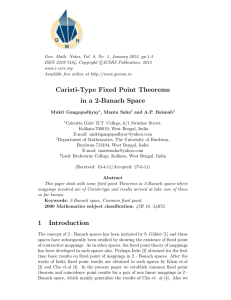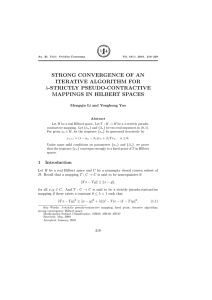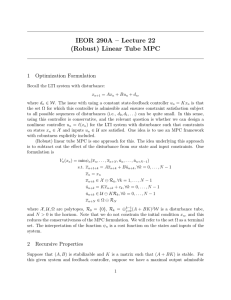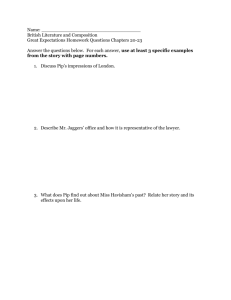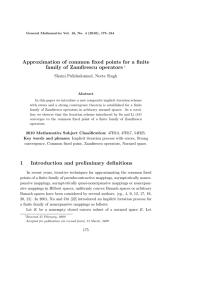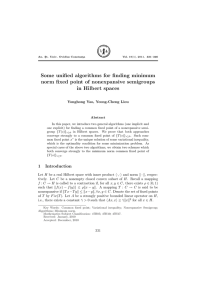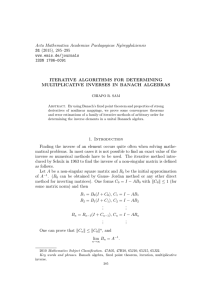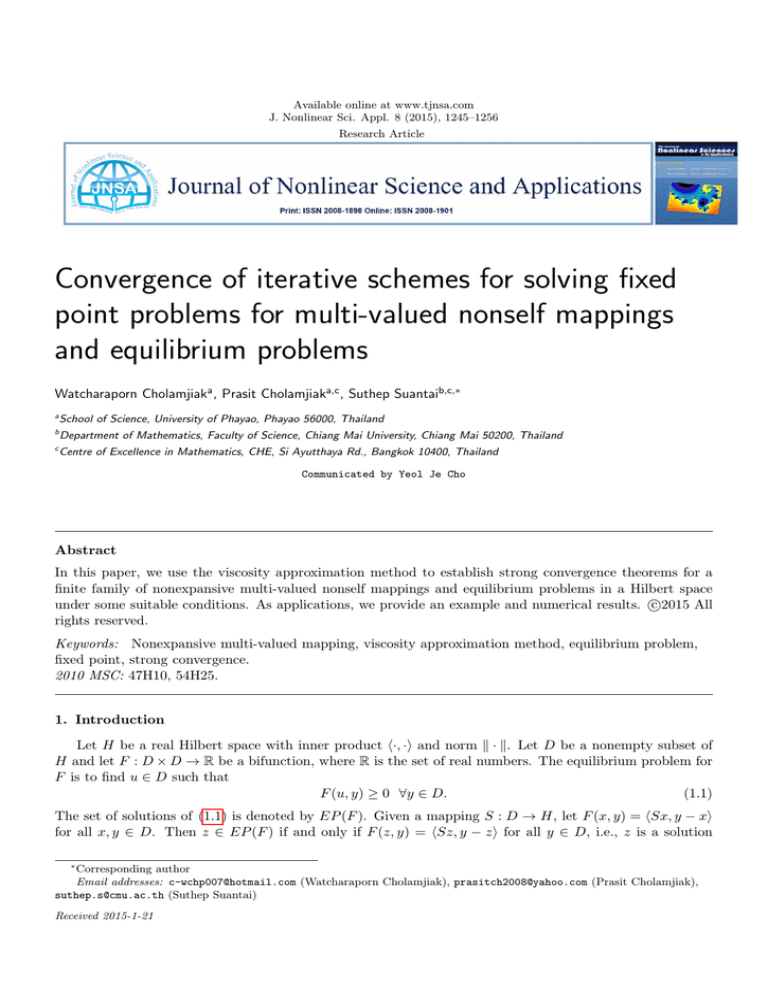
Available online at www.tjnsa.com
J. Nonlinear Sci. Appl. 8 (2015), 1245–1256
Research Article
Convergence of iterative schemes for solving fixed
point problems for multi-valued nonself mappings
and equilibrium problems
Watcharaporn Cholamjiaka , Prasit Cholamjiaka,c , Suthep Suantaib,c,∗
a
School of Science, University of Phayao, Phayao 56000, Thailand
b
Department of Mathematics, Faculty of Science, Chiang Mai University, Chiang Mai 50200, Thailand
c
Centre of Excellence in Mathematics, CHE, Si Ayutthaya Rd., Bangkok 10400, Thailand
Communicated by Yeol Je Cho
Abstract
In this paper, we use the viscosity approximation method to establish strong convergence theorems for a
finite family of nonexpansive multi-valued nonself mappings and equilibrium problems in a Hilbert space
c
under some suitable conditions. As applications, we provide an example and numerical results. 2015
All
rights reserved.
Keywords: Nonexpansive multi-valued mapping, viscosity approximation method, equilibrium problem,
fixed point, strong convergence.
2010 MSC: 47H10, 54H25.
1. Introduction
Let H be a real Hilbert space with inner product h·, ·i and norm k · k. Let D be a nonempty subset of
H and let F : D × D → R be a bifunction, where R is the set of real numbers. The equilibrium problem for
F is to find u ∈ D such that
F (u, y) ≥ 0 ∀y ∈ D.
(1.1)
The set of solutions of (1.1) is denoted by EP (F ). Given a mapping S : D → H, let F (x, y) = hSx, y − xi
for all x, y ∈ D. Then z ∈ EP (F ) if and only if F (z, y) = hSz, y − zi for all y ∈ D, i.e., z is a solution
∗
Corresponding author
Email addresses: c-wchp007@hotmail.com (Watcharaporn Cholamjiak), prasitch2008@yahoo.com (Prasit Cholamjiak),
suthep.s@cmu.ac.th (Suthep Suantai)
Received 2015-1-21
W. Cholamjiak, P. Cholamjiak, S. Suantai, J. Nonlinear Sci. Appl. 8 (2015), 1245–1256
1246
of the variational inequality. The equilibrium problem (1.1) includes as special cases numerous problems in
physics, optimization and economics. Methods for solving the equilibrium problem have been studied by
many authors (see, for example, [4, 5, 6, 8, 13, 19]).
The set D is called proximinal if for each x ∈ H, there exists an element y ∈ D such that
kx − yk = d(x, D), where d(x, D) = inf{kx − zk : z ∈ D}. Let CB(D), K(D) and P (D) be the families of nonempty closed bounded subsets, nonempty compact subsets, and nonempty proximinal bounded
subsets of D respectively. The Hausdorff metric on CB(D) is defined by
H(A, B) = max sup d(x, B), sup d(y, A)
x∈A
y∈B
for A, B ∈ CB(D). A single-valued mapping T : D → D is called nonexpansive if kT x − T yk ≤ kx − yk for
all x, y ∈ D. A multi-valued mapping T : D → CB(D) is said to be nonexpansive if H(T x, T y) ≤ kx − yk
for all x, y ∈ D. An element p ∈ D is called a fixed point of T : D → D (resp. T : D → CB(D)) if p = T p
(p ∈ T p, respectively). The set of fixed points of T is denoted by F (T ).
For single-valued nonexpansive mappings, in 2000, Moudafi [11] proved the following strong convergence
theorem:
Theorem M ([11]). Let D be a nonempty, closed and convex subset of a Hilbert space H and let T be a
nonexpansive mapping of D into itself such that F (T ) is nonempty. Let f be a contraction of D into itself
and let {xn } be a sequence defined as follows: x1 ∈ D and
xn+1 =
1
εn
T xn +
f (xn )
1 + εn
1 + εn
for all n ∈ N, where {εn } ⊂ (0, 1) satisfies
lim εn = 0,
n→∞
∞
X
n=1
1
1 εn = ∞ and lim − = 0.
n→∞ εn+1
εn
Then {xn } converges strongly to z ∈ F (T ), where z = PF (T ) f (z) and PF (T ) is the metric projection of H
onto F (T ).
Such a method is called the viscosity approximation method. Recently, Takahashi-Takahashi [20] introduced an iterative scheme by the viscosity approximation method for finding a common element of the
solutions set of (1.1) and the fixed points set of a nonexpansive mapping in a Hilbert space, and proved the
following strong convergence theorem.
Theorem TT ([20]). Let D be a nonempty, closed and convex subset of a Hilbert space H. Let F : D ×D →
R be a bifunction satisfying the following assumptions:
(A1) F (x, x) = 0 for all x ∈ D;
(A2) F is monotone, i.e., F (x, y) + F (y, x) ≤ 0 for all x, y ∈ D;
(A3) for each x, y, z ∈ D,
lim F (tz + (1 − t)x, y) ≤ F (x, y);
t↓0
(A4) for each x ∈ D, y 7→ F (x, y) is convex and lower semicontinuous.
Let T : D → H be a nonexpansive mapping such that F (T ) ∩ EP (F ) 6= ∅, f : H → H be a contraction,
and {xn } and {un } be sequences generated by x1 ∈ H and
F (un , y) + r1n hy − un , un − xn i ≥ 0, ∀y ∈ D,
(1.2)
xn+1 = αn f (xn ) + (1 − αn )T un , n ≥ 1,
P∞
P∞
where {αn } ⊂ [0, 1] and
n } ⊂ (0, ∞) satisfy limn→∞ αn = 0,
n=1 αn = ∞,
n=1 |αn+1 − αn | < ∞,
P{r
lim inf n→∞ rn > 0 and ∞
|r
−
r
|
<
∞.
n
n=1 n+1
Then {xn } and {un } converge strongly to z ∈ F (T ) ∩ EP (F ), where z = PF (T )∩EP (F ) f (z).
W. Cholamjiak, P. Cholamjiak, S. Suantai, J. Nonlinear Sci. Appl. 8 (2015), 1245–1256
1247
In recent years, fixed point theory for nonlinear multi-valued mappings in various spaces has been studied
by many authors (see, for example, [3, 14, 16, 18] and the references therein).
One way of approximating the fixed points of nonlinear multi-valued mappings is to use the concept of
the best approximation operator PT defined by PT x = {y ∈ T x : ky − xk = d(x, T x)}. In 2003, HussainKhan [9] used the best approximation operator PT to study the fixed points of a *-nonexpansive multi-valued
mapping and the strong convergence of its iterates to a fixed point defined on a closed and convex subset
of a Hilbert space. By using the concept of best approximation operator, many authors have found fixed
point results for multi-valued nonself mappings (see, for example, [10, 15, 21]).
In 2010, Zegeye-Shahzad [21] studied the convergence of the viscosity approximation process for nonexpansive nonself multi-valued mappings in Banach spaces.
Theorem ZS ([21]). Let E be a uniformly convex Banach space having a uniformly Gâteaux differentiable norm, D a nonempty closed convex subset of E, and T : D → K(D) a multimap such that PT is
nonexpansive. For given x0 ∈ D, y0 ∈ PT x0 , let {xn } be generated by the algorithm
xn+1 = αn f (xn ) + (1 − αn )yn ,
yn ∈ PT (xn ) such that kyn−1 − yn k = d(yn−1 , PT (xn )), n ≥ 1
(see, e.g.,[18]), where f : D → D is a contraction and {αn } is a real sequence which satisfies the following
conditions:
(i) limn→∞ αn = 0;
P∞
(ii)
n=1 αn = ∞ and
(iii) limn→∞
|αn −αn−1 |
αn
= 0.
If F (T ) 6= ∅, then {xn } converges strongly to a fixed point of T .
In 2011, Song-Cho [17] gave an example of a multi-valued mapping T which is not necessary nonexpansive
but PT is nonexpansive. It is an interesting problem to study the convergence of multi-valued mappings by
using the best approximation operator.
Let H be a Hilbert space and D be a subset of H. A multi-valued mapping T : D → CB(H) is said
to satisfy the condition (A) if kx − pk = d(x, T p) for all x ∈ H and p ∈ F (T ). We see that T satisfies the
condition (A) if and only if T p = {p} for all p ∈ F (T ). It is known that the best approximation operator
PT also satisfies the condition (A).
Motivated by Takahashi-Takahashi [20] and Zegeye-Shahzad [21], we introduce the viscosity approximation method for solving the equilibrium problem and the fixed points problem of a finite family of multivalued nonself mappings in a Hilbert space. In the last section, we also give an example and numerical
results for supporting our method.
2. Preliminaries and lemmas
Let D be a nonempty, closed and convex subset of a Hilbert space H. For every point x ∈ H, there
exists a unique nearest point in D, denoted by PD x, such that
kx − PD xk ≤ kx − yk, ∀y ∈ D.
PD is called the metric projection of H onto D. It is known that PD is a nonexpansive mapping of H onto
D. We also recall the following facts regarding real Hilbert spaces.
Lemma 2.1. Let D be a nonempty, closed and convex subset of a real Hilbert space H and let PD be the
metric projection of H onto D. Let x ∈ H and z ∈ D. Then z = PD x if and only if
hx − z, y − zi ≤ 0,
∀y ∈ D.
W. Cholamjiak, P. Cholamjiak, S. Suantai, J. Nonlinear Sci. Appl. 8 (2015), 1245–1256
1248
Lemma 2.2. Let H be a real Hilbert space. Then the following relations hold:
(i) kx − yk2 = kxk2 − kyk2 − 2hx − y, yi, ∀x, y ∈ H;
(ii) ktx + (1 − t)yk2 = tkxk2 + (1 − t)kyk2 − t(1 − t)kx − yk2 , ∀t ∈ [0, 1] and x, y ∈ H;
(iii) kx + yk2 ≤ kxk2 + 2hy, x + yi, ∀x, y ∈ H.
By using Lemma 2.2 (ii), we can deduce the next result.
Lemma 2.3. Let H be a real Hilbert space. Then for each m ∈ N
k
m
X
ti xi k2 =
i=1
m
X
ti kxi k2 −
i=1
where xi ∈ H, ti , tj ∈ [0, 1] for all i, j = 1, 2, ..., m, and
m
X
ti tj kxi − xj k2 ,
i=1,i6=j
Pm
i=1 ti
= 1.
Lemma 2.4 ([4]). Let D be a nonempty, closed and convex subset of a real Hilbert space H. Let F be a
bifunction from D × D to R satisfying (A1)-(A4) and let r > 0 and x ∈ H. Then there exists z ∈ D such
that
1
F (z, y) + hy − z, z − xi ≥ 0, f or all y ∈ D.
r
Lemma 2.5 ([8]). For r > 0 and x ∈ H, define the mapping Tr : H → D by
1
Tr (x) = z ∈ D : F (z, y) + hy − z, z − xi ≥ 0, ∀y ∈ D .
r
Then the following hold:
(i) Tr is single-valued;
(ii) Tr is firmly nonexpansive, i.e., for any x, y ∈ H,
kTr x − Tr yk2 ≤ hTr x − Tr y, x − yi;
(iii) F (Tr ) = EP (F );
(iv) EP (F ) is closed and convex.
Lemma 2.6 ([1]). Let D be a nonempty and weakly compact subset of a Hilbert space H and T : D → K(H)
be a nonexpansive mapping. Then I − T is demiclosed.
Lemma
2.7 ([2]). Let {sn } be a sequence of nonnegative real numbers,
P∞
P∞ {αn } be a sequence in [0, 1] with
α
=
∞,
{β
}
be
a
sequence
of
nonnegative
real
numbers
with
n
n
n=1 βn < ∞, and {γn } be a sequence
n=1
of real numbers with lim supn→∞ γn ≤ 0. Suppose that
sn+1 = (1 − αn )sn + αn γn + βn
for all n ∈ N. Then limn→∞ sn = 0.
Lemma 2.8 ([7]). Let D be a closed and convex subset of a real Hilbert space H. Let T : D → CB(D) be
a nonexpansive multi-valued map with F (T ) 6= ∅ and T p = {p} for each p ∈ F (T ). Then F (T ) is a closed
and convex subset of D.
Using the above results, we study the convergence of the iteration (2.1) defined in the following. Let D
be a nonempty, closed and convex subset of a Hilbert space H. Let Ti : D → CB(H) be a multi-valued
nonself mapping for all i ∈ {1, 2, ..., N }, f : H → H be a contraction and F : D × D → R be a bifunction.
W. Cholamjiak, P. Cholamjiak, S. Suantai, J. Nonlinear Sci. Appl. 8 (2015), 1245–1256
Let {α0,n } and {αi,n } be sequences in [0, 1] for all i ∈ {1, 2, ..., N } with
sequence in (0, ∞). For a given x1 ∈ H, we find u1 ∈ D such that
F (u1 , y) +
PN
k=0 αk,n
1249
= 1, and {rn } be a
1
hy − u1 , u1 − x1 i ≥ 0, ∀y ∈ D.
r1
Let zi,1 ∈ Ti u1 for all i ∈ {1, 2, ..., N } and compute x2 ∈ H by
x2 = α0,1 f (x1 ) +
N
X
αi,1 zi,1 .
i=1
Find u2 ∈ D such that
1
hy − u2 , u2 − x2 i ≥ 0, ∀y ∈ D.
r2
From Nadler’s Theorem (see [12]), there exist zi,2 ∈ Ti u2 for all i ∈ {1, 2, ..., N } such that kzi,2 − zi,1 k ≤
H(Ti u2 , Ti u1 ) for all i ∈ {1, 2, ..., N }.
Inductively, we construct the sequence {xn } ⊂ H as follows:
F (un , y) + r1n hy − un , un − xn i ≥ 0, ∀y ∈ D,
P
(2.1)
xn+1 = α0,n f (xn ) + N
i=1 αi,n zi,n , ∀n ≥ 1,
F (u2 , y) +
where zi,n ∈ Ti un such that kzi,n+1 − zi,n k ≤ H(Ti un+1 , Ti un ) for all i ∈ {1, 2, ..., N }.
3. Main results
In this section, we prove a strong convergence theorem for the iteration (2.1) to find a common element of
the solutions set of an equilibrium problem and the common fixed points sets of a finite family of multi-valued
nonself mappings.
Theorem 3.1. Let D be a nonempty, and weakly compact subset of a Hilbert space H. Let F be a bifunction
from D × D to R satisfying (A1)-(A4)
and {Ti }N
i=1 a family of nonexpansive multi-valued mappings of D
T
N
into K(H) such that ∩i=1 F (Ti ) EP (F ) 6= ∅. Let f be a contraction of H into itself. Let {α0,n }, {αi,n } be
P
sequences in [0, 1] with N
k=0 αk,n = 1 and {rn } ⊂ (0, ∞) be a sequence such that the following hold:
P∞
(i) P
limn→∞ α0,n = 0,
n=1 α0,n = ∞, lim inf n→∞ αi,n αj,n > 0 for all i, j ∈ {1, 2, ..., N } and
∞
∞ for all k ∈ {0, 1, 2, ..., N };
n=1 |αk,n+1 − αk,n | <P
(ii) lim inf n→∞ rn > 0 and ∞
n=1 |rn+1 − rn | < ∞.
If {Ti }N
i=1 satisfies theTcondition (A), then the sequences {xn } and {un } generated by (2.1) converge
strongly to z ∈ ∩N
EP (F ), where z = P∩N F (Ti ) T EP (F ) f (z).
i=1 F (Ti )
i=1
Proof. Let Q = P∩N F (Ti ) EP (F ) . Since f is a contraction, there exists a constant α ∈ [0, 1) such that
i=1
kQf (x) − Qf (y)k ≤ kf (x) − f (y)k ≤ αkx − yk for all x, y ∈ H. Hence Qf is a contraction of H into itself,
so there exists a unique element z ∈ H such that z = Qf (z). We divide the proof into five steps.
Step 1. We show T
that {xn } is bounded.
N
Let p ∈ ∩i=1 F (Ti ) EP (F ). Then from un = Trn xn , we have
T
kun − pk = kTrn xn − Trn pk ≤ kxn − pk
for all n ≥ 1. It follows that
kxn+1 − pk ≤ α0,n kf (xn ) − pk +
= α0,n kf (xn ) − pk +
N
X
i=1
N
X
i=1
αi,n kzi,n − pk
αi,n d(zi,n , Ti p)
(3.1)
W. Cholamjiak, P. Cholamjiak, S. Suantai, J. Nonlinear Sci. Appl. 8 (2015), 1245–1256
≤ α0,n kf (xn ) − pk +
N
X
1250
αi,n H(Ti un , Ti p)
i=1
N
X
≤ α0,n kf (xn ) − f (p)k + kf (p) − pk +
αi,n kun − pk
i=1
≤ 1 − α0,n (1 − α) kxn − pk + α0,n kf (p) − pk
1
kf (p) − pk .
≤ max kxn − pk,
(1 − α)
By induction,
kxn − pk ≤ max kx1 − pk,
1
kf (p) − pk , ∀n ≥ 1.
(1 − α)
Hence {xn } is bounded. The same holds for {un }, {f (xn )} and {zi,n } for all i ∈ {1, 2, ..., N }.
Step 2. We show that kxn+1 − xn k → 0 as n → ∞.
From the definition of {xn } there exist zi,n+1 ∈ Ti un+1 and zi,n ∈ Ti un for all i ∈ {1, 2, ..., N } such that
P
kzi,n+1 − zi,n k ≤ H(Ti un+1 , Ti un ). Let K = supn≥1 {kf (xn )k + N
i=1 kzi,n k}. Then, we have
kxn+2 − xn+1 k = kα0,n+1 f (xn+1 ) − α0,n+1 f (xn ) + α0,n+1 f (xn ) − α0,n f (xn )
+
N
X
αi,n+1 zi,n+1 −
i=1
N
X
αi,n+1 zi,n +
i=1
N
X
αi,n+1 zi,n −
i=1
N
X
αi,n zi,n k
i=1
≤ α0,n+1 kf (xn+1 ) − f (xn )k + |α0,n+1 − α0,n |kf (xn )k
+
N
X
αi,n+1 kzi,n+1 − zi,n k +
i=1
N
X
|αi,n+1 − αi,n |kzi,n k
i=1
≤ α0,n+1 αkxn+1 − xn k +
≤ α0,n+1 αkxn+1 − xn k +
N
X
i=0
N
X
|αi,n+1 − αi,n |K +
|αi,n+1 − αi,n |K +
i=0
N
X
αi,n+1 H(Ti un+1 , Ti un )
i=1
N
X
αi,n+1 kun+1 − un k.
(3.2)
i=1
On the other hand, from un = Trn xn and un+1 = Trn+1 xn+1 , we have
F (un , y) +
1
hy − un , un − xn i ≥ 0
rn
(3.3)
for all y ∈ D and
F (un+1 , y) +
1
rn+1
hy − un+1 , un+1 − xn+1 i ≥ 0
for all y ∈ D. Setting y = un+1 in (3.3) and y = un in (3.4), we obtain
F (un , un+1 ) +
and
F (un+1 , un ) +
1
hun+1 − un , un − xn i ≥ 0
rn
1
rn+1
hun − un+1 , un+1 − xn+1 i ≥ 0.
It follows from (A2) that
un − xn un+1 − xn+1
un+1 − un ,
−
rn
rn+1
≥0
(3.4)
W. Cholamjiak, P. Cholamjiak, S. Suantai, J. Nonlinear Sci. Appl. 8 (2015), 1245–1256
and hence
1251
rn
un+1 − un , un − un+1 + un+1 − xn −
(un+1 − xn+1 ) ≥ 0.
rn+1
Since lim inf n→∞ rn > 0, there exists a real number a such that rn > a > 0 for all n ≥ 1. Then, we have
rn
(un+1 − xn+1 )
kun+1 − un k2 ≤ un+1 − un , xn+1 − xn + 1 −
r
n+1 rn ≤ kun+1 − un k kxn+1 − xn k + 1 −
kun+1 − xn+1 k
rn+1 and hence
1
|rn+1 − rn |kun+1 − xn+1 k
rn+1
1
≤ kxn+1 − xn k + |rn+1 − rn |M,
a
kun+1 − un k ≤ kxn+1 − xn k +
(3.5)
where M = sup{kun − xn k : n ≥ 1}. Combining (3.2) and (3.5), we obtain
kxn+2 − xn+1 k ≤ α0,n+1 αkxn+1 − xn k +
N
X
|αi,n+1 − αi,n |K +
i=0
N
X
i=1
= 1 − α0,n+1 (1 − α) kxn+1 − xn k +
N
X
i=0
1
αi,n+1 kxn+1 − xn k + |rn+1 − rn |M
a
1
|αi,n+1 − αi,n |K + |rn+1 − rn |M.
a
By Lemma 2.7, kxn+1 − xn k → 0 as n → ∞.
Step 3. We show that limn→∞ kxn − zi,n k = limn→∞ kun − zi,n k = 0 for all i ∈ {1, 2, ..., N }.
From (3.5) and (ii), we have
lim kun+1 − un k = 0.
n→∞
T
Let p ∈ ∩N
EP (F ). From Lemma 2.3 and (3.1), we get
i=1 F (Ti )
kxn+1 − pk2 ≤ α0,n kf (xn ) − pk2 +
= α0,n kf (xn ) − pk2 +
≤ α0,n kf (xn ) − pk2 +
N
X
i=1
N
X
i=1
N
X
(3.6)
αi,n kzi,n − pk2 − αj,n αk,n kzj,n − zk,n k2
αi,n d(zi,n , Ti p)2 − αj,n αk,n kzj,n − zk,n k2
αi,n H(Ti un , Ti p)2 − αj,n αk,n kzj,n − zk,n k2
i=1
2
≤ α0,n kf (xn ) − pk + kun − pk2 − αj,n αk,n kzj,n − zk,n k2
≤ α0,n kf (xn ) − pk2 + kxn − pk2 − αj,n αk,n kzj,n − zk,n k2
for all j, k ∈ {1, 2, ..., N }. It follows that
αj,n αk,n kzj,n − zk,n k2 ≤ α0,n kf (xn ) − pk2 + kxn − pk2 − kxn+1 − pk2
≤ α0,n kf (xn ) − pk2 + kxn+1 − xn k kxn − pk + kxn+1 − pk
for all j, k ∈ {1, 2, ..., N }. From (i), we have that kzj,n − zk,n k → 0 as n → ∞ for all j, k ∈ {1, 2, ..., N }. This
implies that
kxn − zi,n k ≤ kxn − xn+1 k + kxn+1 − zi,n k → 0
(3.7)
W. Cholamjiak, P. Cholamjiak, S. Suantai, J. Nonlinear Sci. Appl. 8 (2015), 1245–1256
as n → ∞ for all i ∈ {1, 2, ..., N }. For p ∈ ∩N
i=1 F (Ti )
T
1252
EP (F ), we see that
kun − pk2 = kTrn xn − Trn pk2
≤ hTrn xn − Trn p, xn − pi
= hun − p, xn − pi
1
2
2
2
kun − pk + kxn − pk − kxn − un k ,
=
2
which yields
kun − pk2 ≤ kxn − pk2 − kxn − un k2 .
Therefore, using the convexity of k · k2 , we obtain
kxn+1 − pk2 = kα0,n f (xn ) +
N
X
αi,n zi,n − pk2
i=1
2
≤ α0,n kf (xn ) − pk +
= α0,n kf (xn ) − pk2 +
≤ α0,n kf (xn ) − pk2 +
N
X
i=1
N
X
i=1
N
X
αi,n kzi,n − pk2
αi,n d(zi,n , Ti p)2
αi,n H(Ti un , Ti p)2
i=1
2
≤ α0,n kf (xn ) − pk + (1 − α0,n )kun − pk2
≤ α0,n kf (xn ) − pk2 + (1 − α0,n ) kxn − pk2 − kxn − un k2
≤ α0,n kf (xn ) − pk2 + kxn − pk2 − (1 − α0,n )kxn − un k2 ,
whence
(1 − α0,n )kxn − un k2 ≤ α0,n kf (xn ) − pk2 + kxn − pk2 − kxn+1 − pk2
≤ α0,n kf (xn ) − pk2 + kxn+1 − xn k kxn − pk + kxn+1 − pk .
Since limn→∞ α0,n = 0 and limn→∞ kxn+1 − xn k = 0, we have
kxn − un k → 0
(3.8)
as n → ∞. It follows from (3.7) and (3.8) that, for each i = 1, 2, ..., N ,
kzi,n − un k ≤ kzi,n − xn k + kxn − un k → 0
(3.9)
as n → ∞.
Step 4. We show that lim supn→∞ hf (z) − z, xn − zi ≤ 0, where z = P∩N F (Ti ) T EP (F ) f (z).
i=1
Since {xn } is bounded, we can choose a subsequence {xni } of {xn } such that
lim hf (z) − z, xni − zi = lim suphf (z) − z, xn − zi.
i→∞
n→∞
Since {un } is bounded, we infer that uni * q ∈ D and also xni → q. We will now show that q ∈ EP (F ).
From un = Trn xn , we have
F (un , y) +
1
hy − un , un − xn i ≥ 0, ∀y ∈ D.
rn
W. Cholamjiak, P. Cholamjiak, S. Suantai, J. Nonlinear Sci. Appl. 8 (2015), 1245–1256
1253
Also, from (A2),
1
hy − un , un − xn i ≥ F (y, un )
rn
and hence
Since
uni −xni
rni
un − xni
y − uni , i
rni
≥ F (y, uni ).
→ 0 and uni * q, from (A4) we have
0 ≥ F (y, q)
for all y ∈ D. For t with 0 < t ≤ 1 and y ∈ D, let yt = ty + (1 − t)q. Since y ∈ D and q ∈ D, yt ∈ D, hence
F (yt , q) ≤ 0. Consequently, from (A1) and (A4) we get
0 = F (yt , yt ) ≤ tF (yt , y) + (1 − t)F (yt , q) ≤ tF (yt , y)
and thus 0 ≤ F (yt , y). It follows that 0 ≤ F (q, y) for all y ∈ D by (A3), and hence q ∈ EP (F ). Since
limn→∞ kzi,n − un k = 0 and
T uni * q, using Lemma 2.6, we obtain that q ∈ F (Ti ) for all i ∈ {1, 2, ..., N }.
Therefore q ∈ ∩N
F
(T
)
EP (F ). By Lemma 2.1, we have
i
i=1
lim suphf (z) − z, xn − zi = lim hf (z) − z, xni − zi = hf (z) − z, q − zi ≤ 0.
i→∞
n→∞
(3.10)
Step 5. We show that xn → z as n → ∞.
From Lemma 2.2 (iii) we have
kxn+1 − zk2 ≤
=
≤
N
X
i=1
N
X
i=1
N
X
2
αi,n
kzi,n − zk2 + 2α0,n hf (xn ) − z, xn+1 − zi
2
αi,n
d(zi,n , Ti z)2 + 2α0,n hf (xn ) − z, xn+1 − zi
2
αi,n
H(Ti un , Ti z)2 + 2α0,n hf (xn ) − z, xn+1 − zi
i=1
≤ (1 − α0,n )2 kun − zk2 + 2α0,n hf (xn ) − f (z), xn+1 − zi + 2α0,n hf (z) − z, xn+1 − zi
≤ (1 − α0,n )2 kxn − zk2 + 2α0,n αkxn − zkkxn+1 − zk + 2α0,n hf (z) − z, xn+1 − zi
2
2
2
2
≤ (1 − α0,n ) kxn − zk + α0,n α kxn − zk + kxn+1 − zk + 2α0,n hf (z) − z, xn+1 − zi.
This implies that
2α0,n
(1 − α0,n )2 + α0,n α
kxn − zk2 +
hf (z) − z, xn+1 − zi
1 − α0,n α
1 − α0,n α
2
α0,n
1 − 2α0,n + α0,n α
2α0,n
=
kxn − zk2 +
kxn − zk2 +
hf (z) − z, xn+1 − zi
1 − α0,n α
1 − α0,n α
1 − α0,n α
2(1 − α)α0,n
= 1−
kxn − zk2
1 − α0,n α
2(1 − α)α0,n
α0,n
1
+
kxn − zk2 +
hf (z) − z, xn+1 − zi .
1 − α0,n α
2(1 − α)
1−α
kxn+1 − zk2 ≤
Put
γn =
α0,n
1
kxn − zk2 +
hf (z) − z, xn+1 − zi.
2(1 − α)
1−α
W. Cholamjiak, P. Cholamjiak, S. Suantai, J. Nonlinear Sci. Appl. 8 (2015), 1245–1256
1254
2
It follows from (i) and (3.10) that lim supn→∞ γT
n ≤ 0, so limn→∞ kxn − zk = 0 by Lemma 2.7. This implies
that {xn } converges strongly to z ∈ ∩N
EP (F ). It is easily seen that {un } also converges strongly
i=1 F (Ti )
to z. We thus complete the proof.
If, for each i = 1, 2, ..., N , Ti p = {p} for all p ∈ F (Ti ), then {Ti }N
i=1 satisfies the condition (A). We then
obtain the following result.
Corollary 3.2. Let D be a nonempty and weakly compact subset of a Hilbert space H. Let F be a bifunction from D × D to R satisfying
(A1)-(A4) and {Ti }N
i=1 be nonexpansive multi-valued mappings of D into
T
N
K(H) such that ∩i=1 F (Ti ) EP (F ) 6= ∅. Let f be a contraction of H into itself, and let {α0,n }, {αi,n }
(i = 1, 2, ..., N ) and {rn } be as in Theorem 3.1. If, for each i = 1, 2, ..., N , Ti p = {p} for
T all p ∈ F (Ti ),
then the sequences {xn } and {un } generated by (2.1) converge strongly to z ∈ ∩N
F
(T
)
EP (F ), where
i
i=1
T
z = P∩N F (Ti ) EP (F ) f (z).
i=1
Since PTi (i = 1, 2, ..., N ) satisfies the condition (A), we also obtain
Corollary 3.3. Let D be a nonempty and weakly compact subset of a Hilbert space H. Let F be a bifunction
from D×D to RTsatisfying (A1)-(A4) and {Ti }N
i=1 be a family of multi-valued mappings of D into P (H) such
N
that ∩i=1 F (Ti ) EP (F ) 6= ∅ and F (Ti ) is closed and convex for all i ∈ {1, 2, ..., N }. Let f be a contraction
of H into itself, and let {α0,n }, {αi,n } (i = 1, 2, ..., N ), and {rn } be as in Theorem 3.1. Let the sequences
{xn } and {un } be generated as follows:
F (un , y) + r1n hy − un , un − xn i ≥ 0, ∀y ∈ D,
P
(3.11)
xn+1 = α0,n f (xn ) + N
i=1 αi,n zi,n ,
where zi,n ∈ PTi un such that kzi,n+1 − zi,n k ≤ H(PTi un+1 , PTi un ).
If PTi is nonexpansive and I − Ti is demiclosed
at 0 for all i ∈ {1, 2, ..., N }, then the sequences {xn } and
T
{un } converge strongly to z ∈ ∩N
F
(T
)
EP
(F
),
where z = P∩N F (Ti ) T EP (F ) f (z).
i
i=1
i=1
4. Example and numerical results
In this section, we give an example and numerical results supporting our main theorem.
Example 4.1. Let H = R and D = [0, 1]. Let F (x, y) = −9x2 + xy + 8y 2 , f (x) =
1
n
T2 x = [0, sin x] and let α0,n = 80n
, α1,n = α2,n = 80n−1
160n and rn = n+1 .
x
2,
T1 x = [0, x2 ],
It is easy to check that F satisfies all the conditions in Theorem 3.1. For each r > 0 and x ∈ [0, 1],
Lemma 2.4 ensures that there exists z ∈ [0, 1] such that, for any y ∈ [0, 1],
1
1
F (x, y) + hy − z, z − xi ≥ 0 ⇔ −9z 2 + zy + 8y 2 + (y − z)(z − x) ≥ 0
r
r
2
⇔ 8ry + (zr + z + x)y + (xz − 9rz 2 − z 2 ) ≥ 0.
Put G(y) = 8ry 2 + (zr + z + x)y + (xz − 9rz 2 − z 2 ). Then G is a quadratic function of y with coefficients
a = 8r, b = rz + z + x and c = xz − 9rz 2 − z 2 . We next compute the discriminant ∆ of G as follows:
∆ = b2 − 4ac
= (1 + r)z − x
2
− 32r(xz − 9rz 2 − z 2
= x2 − 2x(1 + r)z + (1 + r)2 z 2 − 32rxz + 288r2 z 2 + 32rz 2
= x2 − 34rxz − 2xz + 289r2 z 2 + 34rz 2 + z 2
= x2 − 2x(17rz + z) + (17rz + z)2
2
= x − (17rz + z) .
W. Cholamjiak, P. Cholamjiak, S. Suantai, J. Nonlinear Sci. Appl. 8 (2015), 1245–1256
1255
We know that G(y) ≥ 0 for all y ∈ [0, 1] if it has at most one solution in [0, 1]. So 4 ≤ 0 and hence
x
x = 17rz + z. Now we have z = Tr x = (17r+1)
. Algorithm (2.1) becomes
xn
80n − 1
+
z1,n + z2,n , ∀n ≥ 1,
160n
160n
xn
∈ 0, sin 17( n )+1 are such that
xn+1 =
where z1,n
∈ 0,
, z2,n
xn
n
2 17( n+1
)+1
|z1,n+1 − z1,n | ≤ H 0,
n+1
xn+1
n+1
2 17( n+2
)+1
, 0,
xn
n
2 17( n+1
)+1
x
x
n+1
n
−
= n
n+1
2 17( n+1 ) + 1
2 17( n+2 ) + 1
and
xn
xn+1
, 0, sin
n
17( n+1
)+1
17( n+1
n+2 ) + 1
xn+1
xn
= sin
− sin
n
n+1
17( n+1 ) + 1 17( n+2 ) + 1
|z2,n+1 − z2,n | ≤ H 0, sin
for all n ≥ 1. Choose x1 = 1 and take randomly z1,n , z2,n satisfying the above conditions. We then have
n
z1,n
z2,n
xn
|xn+1 − xn |
1
2.68763620E-02
3.18914138E-02
1.00000000E+00
9.67674761E-01
2
1.03550828E-03
1.27284146E-03
3.23252386E-02
3.11085285E-02
3
1.90384562E-05
4.33038000E-06
1.21671005E-03
1.20316104E-03
4
1.08825740E-07
5.58886787E-08
1.35490137E-05
1.34499262E-05
5
8.68977905E-10
2.18228584E-10
9.90875836E-08
9.84418966E-08
6
2.07077239E-11
1.68185074E-11
6.45686971E-10
6.26380855E-10
7
1.33453390E-13
1.77800965E-13
1.93061163E-11
1.91356494E-11
8
3.32911503E-15
1.17262475E-16
1.70466913E-13
1.68627738E-13
9
2.34667065E-17
1.85492397E-17
1.83917524E-15
1.81704404E-15
10
..
.
1.94968136E-19
..
.
2.60343261E-19
..
.
2.21311977E-17
..
.
2.18912261E-17
..
.
50
7.95313036E-94
5.60964135E-94
3.24048135E-92
6.27814377E-93
Table 1 Numerical results of Example 4.1 being randomized the first time.
n
z1,n
z2,n
xn
|xn+1 − xn |
1
3.87646646E-02
2.11808262E-02
1.00000000E+00
9.67089584E-01
2
9.08427596E-04
5.17399890E-04
3.29104157E-02
3.21319091E-02
3
9.82766561E-07
1.29163897E-06
7.78506635E-04
7.76156570E-04
4
6.53081245E-08
1.19028080E-08
2.35006562E-06
2.30861909E-06
5
1.33075088E-09
3.64430816E-10
4.14465346E-08
4.05575361E-08
6
2.68341046E-11
1.50264282E-11
8.88998510E-10
8.67311870E-10
7
2.73653976E-13
4.49152288E-13
2.16866396E-11
2.13088585E-11
8
1.15014750E-14
6.10767047E-16
3.77781126E-13
3.71471069E-13
9
8.23396605E-17
8.77593543E-17
6.31005777E-15
6.22117079E-15
10
..
.
9.57108690E-19
..
.
5.14323658E-19
..
.
8.88869817E-17
..
.
8.81015976E-17
..
.
50
8.74865895E-97
6.97685899E-97
2.03284925E-94
2.03284925E-94
Table 2 Numerical results of Example 4.1 being randomized the second time.
From Table 1 and Table 2, we see that 0 is the solution of the equilibrium problem and it is the common
fixed point of T1 and T2 in Example 4.1.
W. Cholamjiak, P. Cholamjiak, S. Suantai, J. Nonlinear Sci. Appl. 8 (2015), 1245–1256
1256
Acknowledgements:
W. Cholamjiak thanks University of Phayao. The second and the third authors wish to thank the Centre
of Excellence in Mathematics, the Commission on Higher Education, Thailand. The authors would like to
thank Professor Yeol Je Cho for giving useful suggestions and comments for the improvement of this paper.
References
[1] R. P. Agarwal, D. O’Regan, D. R. Sahu, Fixed Point Theory for Lipschitzian-type Mappings with Applications,
Springer, New York, (2009). 2.6
[2] K. Aoyama, Y. Kimura, W. Takahashi, M. Toyoda, Approximation of common fixed points of a countable family
of nonexpansive mappings in a Banach space, Nonlinear Anal., 67 (2007), 2350–2360. 2.7
[3] N. A. Assad, W. A. Kirk, Fixed point theorems for set-valued mappings of contractive type, Pacific J. Math., 43
(1972), 553–562. 1
[4] E. Blum, W. Oettli, From optimization and variational inequalities to equilibrium problems, Math. Student, 63
(1994), 123–145. 1, 2.4
[5] L. C. Ceng, J. C. Yao, A hybrid iterative scheme for mixed equilibrium problems and fixed point problems, J.
Comput. Appl. Math., 214 (2008), 186–201. 1
[6] P. Cholamjiak, A hybrid iterative scheme for equilibrium problems, variational inequality problems and fixed point
problems in Banach spaces, Fixed Point Theory Appl., 2009 (2009), 18 pages. 1
[7] W. Cholamjiak, S. Suantai, A hybrid method for a countable family of multivalued maps, equilibrium problems,
and variational inequality problems, Discrete Dyn. Nat. Soc., 2010 (2010), 14 pages. 2.8
[8] P. L. Combettes, S. A. Hirstoaga, Equilibrium programming in Hilbert spaces, J. Nonlinear Convex Anal., 6
(2005), 117–136. 1, 2.5
[9] N. Hussain, A. R. Khan, Applications of the best approximation operator to *- nonexpansive maps in Hilbert
spaces, Numer. Funct. Anal. Optim., 24 (2003), 327–338. 1
[10] J. S. Jung, Convergence of approximating fixed points for multivalued nonself-mappings in Banach spaces, Korean
J. Math., 16 (2008), 215–231. 1
[11] A. Moudafi, Viscosity approximation methods for fixed-point problems, J. Math. Anal. Appl., 241 (2000), 46–55.
1, M
[12] S. B. Nadler, Multi-valued contraction mappings, Pacific J. Math. 30 (1969), 475–488. 2
[13] J. W. Peng, Y. C. Liou, J. C. Yao, An iterative algorithm combining viscosity method with parallel method for a
generalized equilibrium problem and strict pseudocontractions, Fixed Point Theory Appl., 2009 (2009), 21 pages.
1
[14] P. Pietramala, Convergence of approximating fixed points sets for multivalued nonexpansive mappings, Comment.
Math. Univ. Carolin., 32 (1991), 697–701. 1
[15] N. Shahzad, H. Zegeye, Strong convergence results for nonself multimaps in Banach spaces, Proc. Amer. Math.
Soc., 136 (2008), 539–548. 1
[16] N. Shahzad, H. Zegeye, On Mann and Ishikawa iteration schemes for multi-valued maps in Banach spaces,
Nonlinear Anal., 71 (2009), 838–844. 1
[17] Y. Song, Y. J. Cho, Some note on Ishikawa iteration for multi-valued mappings, Bull. Korean Math. Soc., 48
(2011), 575–584. 1
[18] Y. Song, H. Wang, Convergence of iterative algorithms for multivalued mappings in Banach spaces, Nonlinear
Anal., 70 (2009), 1547–1556. 1, ZS
[19] A. Tada, W. Takahashi, Strong convergence theorem for an equilibrium problem and a nonexpansive mapping,
Nonlinear Analysis and Convex Analysis, Yokohama Publishers, Yokohama, (2005). 1
[20] S. Takahashi, W. Takahashi, Viscosity approximation methods for equilibrium problems and fixed point problems
in Hilbert spaces, J. Math. Anal. Appl., 331 (2007), 506–515. 1, TT, 1
[21] H. Zegeye, N. Shahzad, Viscosity approximation methods for nonexpansive multimaps in Banach spaces, Acta
Math. Sin., 26 (2010), 1165–1176. 1, ZS, 1

![MA3422 (Functional Analysis 2) Tutorial sheet 4 [February 13, 2015] Name: Solutions](http://s2.studylib.net/store/data/010731573_1-51b86a9dc1da9dadc104f731d9c63f85-300x300.png)
